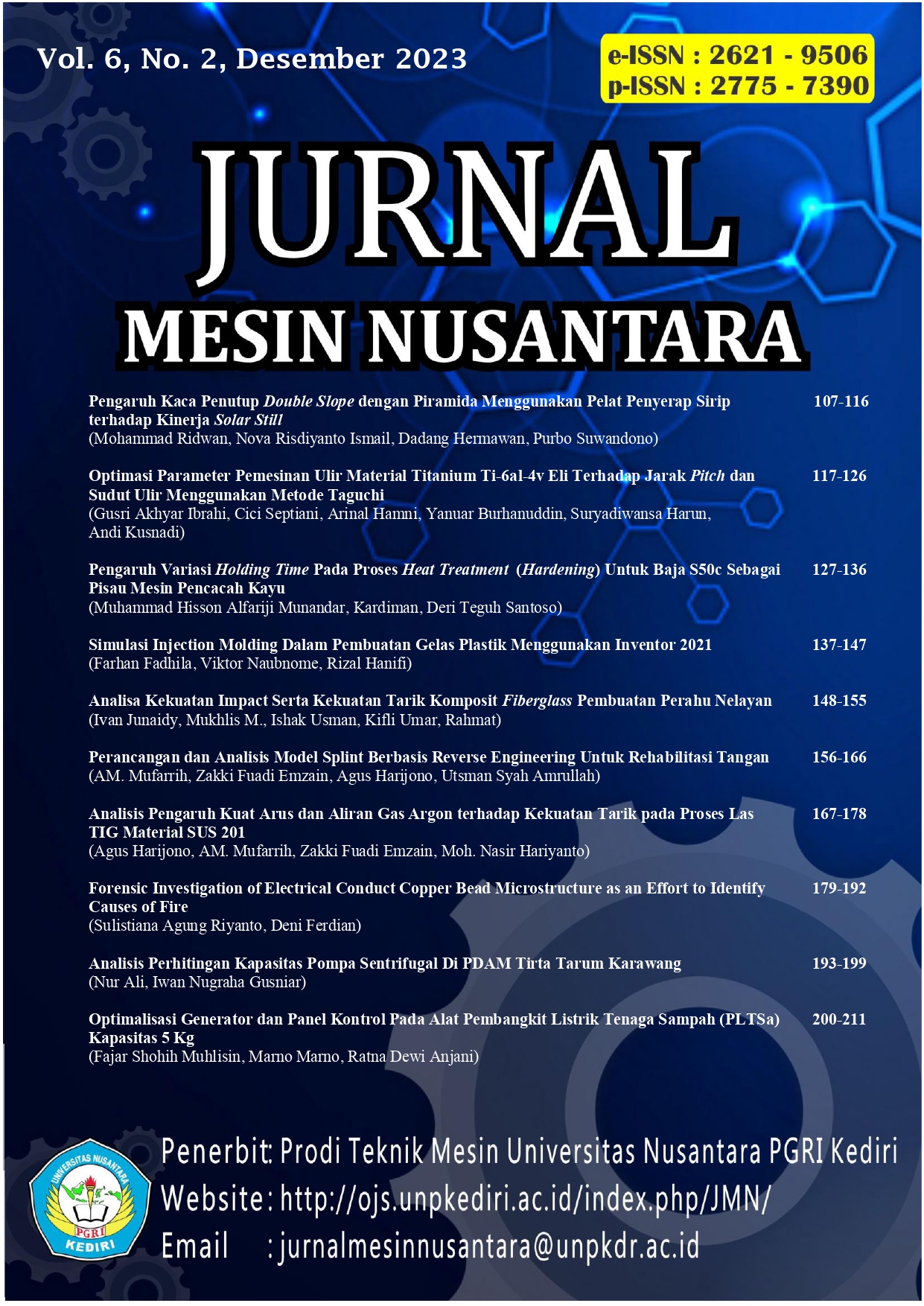Forensic Investigation of Electrical Conduct Copper Bead Microstructure as an Effort to Identify Causes of Fire
DOI:
https://doi.org/10.29407/jmn.v6i2.20180Keywords:
Short circuit, Overload, Direct flame, NYM 3x1.5, BeadAbstract
The purpose of this study was to evaluate the characteristics of the bead formed due to short circuit, overload and direct flame treatment on NYM 3x1.5 copper power cable. Handling of short circuit and overload is carried out at a current load of 800% of the current carrying capacity (144 Amperes) and direct flame treatment is carried out at a temperature of 960 degrees Celsius. The bead specimens formed from each treatment were examined and tested in the laboratory: chemical composition examination, visual inspection, macro and micro structural examination, hardness testing, and SEM-EDS examination. The difference in the characteristics of the arc bead that is formed under short circuit conditions and overload is that in short circuit conditions the damage point is localized at a certain point, namely at the short circuit contact point, while under overload conditions the point damage is localized at one or several specific locations along the wire. The macro characteristic of arc beads formed under short-circuit and overload conditions is that they contain many cavities and a clear transition boundary between the melted/ re-solidified material and the non-melted material. While the characteristics of the granules in the form of globular formed in the direct flame treatment, do not show sharp transitions between melting/ re-solidified materials. The micro structure of NYM 3x1.5 beads of electrically conducting copper wire material under the treatment conditions: short circuit, overload and direct ignition, is an alpha (α) phase dendritic structure.
Downloads
References
Richard J. Roby, Ph.D., Jamie McAllister, Ph.D., Forensic Investigation Techniques for Inspecting Electrical Conductors Involved in Fire, U.S. Department of Justice, 2012.
N.J. Simon, E.S. Drexler, and R.P.Reed, Properties of Copper and Copper Alloys at Cryogenic Temperatures, NIST MN 177.
Peraturan Umum Instalasi Listrik (PUIL) 2000, 2002, Cetakan ke 2, Standar Nasional Indonesia, Badan Standar Nasional.
José Almirall, Hal Arkes, John Lentini, Frederick Mowrer and Janusz Pawliszyn, A Quality and Gap Analysis- Fire Investigation, AAAS Project Advisory Committee, 2017.
Jacob Alan Graham Critchley, The ability for investigators to visible identify and interpret damage to electrical conductors, Eastern Kentucky University, 2019.
ATF Fire Research Laboratory, Visual Characteristics of Fire Melting on Copper Conductors, Technical Bulletin 001, 2012.
Roy Tenno Siburian, Analisis Karakteristik Strukturmikro “Bead” pada Penghantar Listrik Tembaga AkibatHubung Singkat Listrik, Beban Berlebih danPanas Kebakaran, Fakultas Matematika dan Ilmu Pengetahuan Alam Universitas Sumatera Utara, Medan, 2015.
ASM Metals Handook, volume 2, Properties and Selection: Nonferrous and Special Purpose Materials, ASM International, 1990.
Vytenis Babrauskas, Ph.D., Fires due to Electric Arcing: Can ‘Cause’ Beads Be Distinguished from ‘Victim’ Beads by Physical or Chemical Testing?,Fire Science and Technology Inc., 2003.
Thomas R. May, Esq. And David J. Icove, Ph.D., P.E., Arc Mapping Methodologies & the Pursuit of Magical Globules, Notches, & Beads: a bridge too far to establish fire origin?, Lincoln Memorial University, 2020.
Zhijin Yu, Shuangshuang Chen, Jun Deng, Xueyan Xu and Weifeng Wang, Microstructural Characteristics of Arc Beads with Over current Fault in the Fire Scene”, College of Safety Science and Engineering, Xi’an University of Science and Technology, China, 2020.
Wei Mei-mei, Mo Shan-jun, Liang Dong, Li Ji-bo, The Experiment on Melted Mark Formed by Copper Wire in Electrical Fire and the Analytic Researcher on the Feature Parameters of Metallographic Structure, The 5th Conference on Performance-based Fire and Fire Protection Engineering , 2010.
ASM Metals Handook, volume 9, Metallography and Microstructures, ASM International, 1985.
Downloads
Published
Issue
Section
License
Authors who publish with this journal agree to the following terms:
- Copyright on any article is retained by the author(s).
- The author grants the journal, right of first publication with the work simultaneously licensed under a Creative Commons Attribution License that allows others to share the work with an acknowledgment of the work’s authorship and initial publication in this journal.
- Authors are able to enter into separate, additional contractual arrangements for the non-exclusive distribution of the journal’s published version of the work (e.g., post it to an institutional repository or publish it in a book), with an acknowledgment of its initial publication in this journal.
- Authors are permitted and encouraged to post their work online (e.g., in institutional repositories or on their website) prior to and during the submission process, as it can lead to productive exchanges, as well as earlier and greater citation of published work.
- The article and any associated published material is distributed under the Creative Commons Attribution-ShareAlike 4.0 International License












